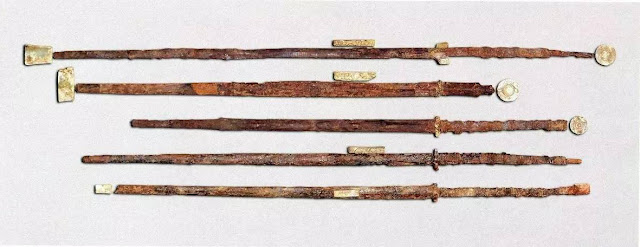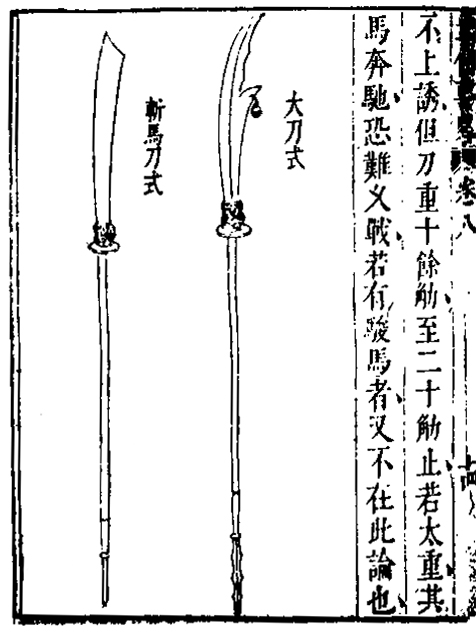Like many Chinese weapons, the famous Zhan Ma Dao (斬馬刀, 'Horse-chopping sabre') has been subject to a lot of misinformations and misconceptions. Over the course of China's long history, the term had been applied to many different weapons, which led to confusion over the true origin and purposes of this weapon.
However, upon closer inspection there are indeed traceable similarities between different iterations of Zhan Ma Dao/Jian. In general, they can be roughly grouped into three types:
Type A: Executioner's sword (Han–early Song period)
Very little is known about the horse chopper of this period. Based on its name ("Jian" instead of "Dao"), it is believed that the weapon is a double-edged sword, although its size and shape remain a mystery.
Han Dynasty Zhan Ma Jian (斬馬劍, lit. 'Horse-chopping sword')
 |
| Five surviving Han period Jian. All swords in this photo, save for the second one from the top, are designed for two-handed use, the longest one being 146 cm in length. All swords are currently kept at Museum of the Mausoleum of the Nanyue King, Guangzhou, China. It should be noted that none of these swords are explicitly stated to be Zhan Ma Jian, although an actual example (if any survives) should look quite similar to these swords. |
More properly known as Duan Ma Jian (斷馬劍, lit. 'Horse-severing sword'), this weapon is actually a sword of state, made specifically for the emperor for ceremonial purpose and to execute treacherous officials. The sword is believed to acquire its name from the White Horse Oath (白馬之盟), in which a white horse was ritually slaughtered and its blood wiped on the participants' lips as a symbolism of the oath of loyalty and upholding the bloodline of Han emperor Liu Bang (劉邦).
Sui and Tang Dynasty Mo Dao (陌刀)
Many Mo Dao users were exceptionally strong individuals, but the most famous one was probably Tang general Li Si Ye (李嗣業), who used the weapon to great effect to stop the pursuing Abbasid army after Tang army was defeated during Battle of Talas.
To date, no surviving Mo Dao has been discovered. Drawing upon descriptions found in various Tang Dynasty texts, Mo Dao seems to be a type of double-edged chopping polearm, up to one zhang (118.1 in or 300 cm) in length and fifteen catties (22.48 pounds or 10.2 kg) in weight (after all, Mo Dao was originally an execution weapon). It is also speculated that Japanese ōmi-yari (大身槍) either descended from, or related to, this weapon.
Type B: Cleaver type (Song–Qing period)
Whether a two-handed sword or a polearm, horse choppers of this period inevitably have a long (usually three chi or more) cleaving blade that ends in very steep clip point or so-called "reverse tanto" point (although many Song Dynasty swords have a blunt square point instead). The blade can be straight (Song period) or slightly curved (Ming and Qing period).
Song Dynasty Zhan Ma Dao
 |
| Photo of a Song Dynasty sword that matches the description of Zi Zhi Tong Jian Chang Bian. Note that the sword edge is facing downward. Image taken from Thomas Chen's website but original source unknown. |
Unlike earlier Zhan Ma Jian and Mo Dao, Song Dynasty Zhan Ma Dao was mass-produced for the rank and file (there was even a special bureau that produced nothing but Zhan Ma Dao). It was also really designed with the intention to cut down heavily armoured cavalry.
Ming Dynasty Zhan Ma Dao
 |
| A Zhan Ma Dao (left) and a Yan Yue Dao (偃月刀) (right), from 'Wu Bei Yao Lue (《武備要略》)'. |
Incidentally, Zhan Ma Dao is one of the few Chinese weapons that made an impression on contemporary Western observers. In his book titled Neglected Formosa ('t Verwaerlossde Formosa), Frederick Coyett described Koxinga's troops "wielded with both hands a formidable battle-sword fixed to a stick half the length of a man", a description that matches Zhan Ma Dao perfectly.
Although labelled as "Ming Dynasty" Zhan Ma Dao in this blog post, this type of polearm was used well into Qing period.
Type C: Ōdachi-inspired weapon (Ming–Qing period)
Clearly inspired by Japanese ōdachi (大太刀), which was adopted by Ming Chinese as Chang Dao (長刀), this type of Zhan Ma Dao has a long, gently curved blade and hilt designed for two-handed use. While not specifically designed as anti-cavalry weapon, Chang Dao was indeed used as such by Chinese troops, although the name change only happened during Qing period.(It should be noted that the name change was rather more like a military designation of an existing weapon, similar to how AR-15 was designated as M16 by the US military.)
Qing Dynasty Lu Ying Zhan Ma Dao
 |
| Drawing of a Qing Dynasty Zhan Ma Dao, from 'Huang Chao Li Qi Tu Shi (《皇朝禮器圖式》)'. |
For those interested to learn more about Qing period Chinese two-handed sabres, here is a very good article: Chinese long sabers of the Qing dynasty
Other similar weapons
Qing Dynasty "Zhan Ma Jian"
As the sword is a non-regulation weapon and only a handful survived, it does not have an official name. Nevertheless, the sword has been casually referred to as Zhan Ma Jian and certainly looks the part.
Japanese Zanbatō (ざんばとう or 斬馬刀)
 |
| A modern nakamaki nōdachi being advertised as a zanbatō. Note the black wrapping at the lower third of the blade. |
In popular media, any sufficiently large Japanese sword, typically an ōdachi, nakamaki nōdachi (中巻野太刀, a nōdachi sword with the last portion of its blade wrapped in thin cord, which serves as a secondary grip similar to a zweihänder's ricasso/sub-hilt. It is the predecessor of nagamaki) or sometimes a bisentō (眉尖刀), can all be referred to as zanbatō.

Can i ask, did Ming cavalry use Zhan Ma Dao on horseback in the battle?
ReplyDeleteOnly occasionally.
DeleteWas there a Dao version as well in Han dynasty like this photo suggest (tho it is modern)
ReplyDeletehttps://m.imgur.com/AirVJqf
That one is just an ordinary Han period two-handed dao. Both two-handed dao and jian existed during Han period, but they were not called with specific names.
DeleteThanks, so how exactly where these two blades use anyway.
DeleteNo idea. The ways of using Han period dao or jian had been long lost. At best, someone can attempt to explore and reconstruct it a.l.a Roland Warzecha's study on Viking sword.
DeleteI just remembered, skallagrim did a video with swordsage, I think it was mentioned two handed Jian were used by heavy infantry and also this video is Guy mentions the same thing as well saying it was use more like a polearm then a sword.
Deletehttps://youtu.be/g4ncsxwXImk
And it was mostly for thrusting for maximum penetration power(he didn't say where he got that information tho), I guess the Dao version was use in a similar manner for heavy infantry but now I'm wondering was it also use more like a polearm and if the Jian version was use for mostly maximum thrust, was the Dao version for maximum slashing if so what weapon would be the the closest comparison to it?
Yes, I also watched that video. Swordsage's swords are made by LK Chen, who IMO is one of the better swordsmiths to produce accurate Han period weapons (note that Swordsage's first Han jian with elaborate guard is inaccurate). Some of KL Chen's works seem to be on/above the upper ceiling on how large a Han weapon can be though (Swordsage's two-handed jian is gigantic)
DeleteWe know very little about Han Dynasty military to say for certain about what weapon was used by who. Polearms (spear/pike, Ji halberd, and Pi swordstaff) and sword-and-shield seems to be much more common than two-handed sword.
How long is the so called zhan ma jian from the Qing dynasty?
ReplyDelete251cm.
Delete